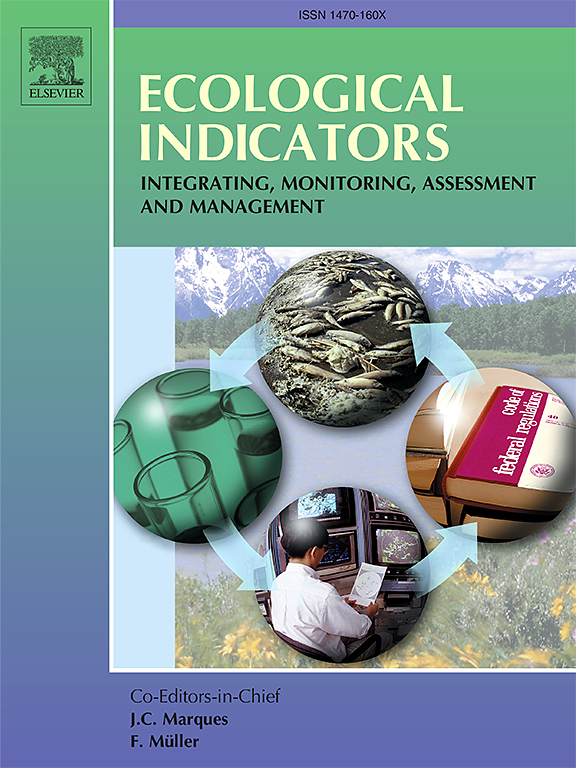浮游植物生物监测的新框架:23S rRNA序列的性状分配
IF 7
2区 环境科学与生态学
Q1 ENVIRONMENTAL SCIENCES
引用次数: 0
摘要
浮游植物是一些立法水管理计划中用来评估湖泊生态状况的重要生物类群。两个前沿的方法,社区表征是DNA元条形码和基于特征的分析。前者提供了一种快速、经济、高通量的群落鉴定方法,后者通过生物生态特征揭示群落结构。本研究的主要目的是将这些方法结合起来,直接将性状分配给扩增子序列变异。为此,我们使用了新开发的Phytool v3参考数据库。使用计算机测试,我们评估了我们的方法的效率和可靠性。结果表明:(1)与属或种水平相比,性状可分配的序列数量更多,可靠性更高;(2)性状在系统发育中具有不同程度的保守性。然后,我们在湖泊环境样本上测试了直接性状分配的有效性。试验结果表明,在不同的环境中,成功分配的序列数量较多,对群落结构有较好的生态解释。此外,我们确定了三个因素(参考库的完整性,序列相似性和参考数据库中邻居的数量),这取决于所考虑的特征,会干扰我们方法的分配成功。虽然DNA元条形码数据可以根据不同的目的以多种方式利用,但我们的研究表明,基于序列直接性状分配的创新框架可以克服参考数据库的空白,进一步提高我们对浮游植物群落结构的认识。本文章由计算机程序翻译,如有差异,请以英文原文为准。
A novel framework for phytoplankton biomonitoring: Trait assignment of 23S rRNA sequences
Phytoplankton is a key biological group used to assess the ecological status of lakes in several legislative water management plans. Two cutting-edge approaches for community characterization are DNA metabarcoding and trait-based analyses. While the former provides a fast, cost-effective and high-throughput methodology for identifying communities, the latter reveals the structure of communities through bio-ecological traits. The main aim of this study was to combine these approaches to directly assign traits to amplicon sequence variants. To achieve this, we used the newly developed Phytool v3 reference database. Using an in silico test, we assessed the efficiency and reliability of our approach. We found: (1) that a greater number of sequences with better reliability can be assigned to traits than to genus or species level and (2) that traits are conserved in the phylogeny with varying extent. Then, we tested the usefulness of direct trait assignment on environmental samples from lakes. The test showed a greater number of successfully assigned sequences and a good ecological interpretation of community structures in the different environments. Furthermore, we identified three factors (completeness of the reference library, sequence similarity and the number of neighbours in the reference database) which, depending on the trait under consideration, interfere with the assignment success of our approach. While DNA metabarcoding data can be exploited in many ways depending on the objectives, our study showed that an innovative framework based on direct trait assignment of sequences could overcome gaps in reference databases and further improve our knowledge of phytoplankton community structure.
求助全文
通过发布文献求助,成功后即可免费获取论文全文。
去求助
来源期刊

Ecological Indicators
环境科学-环境科学
CiteScore
11.80
自引率
8.70%
发文量
1163
审稿时长
78 days
期刊介绍:
The ultimate aim of Ecological Indicators is to integrate the monitoring and assessment of ecological and environmental indicators with management practices. The journal provides a forum for the discussion of the applied scientific development and review of traditional indicator approaches as well as for theoretical, modelling and quantitative applications such as index development. Research into the following areas will be published.
• All aspects of ecological and environmental indicators and indices.
• New indicators, and new approaches and methods for indicator development, testing and use.
• Development and modelling of indices, e.g. application of indicator suites across multiple scales and resources.
• Analysis and research of resource, system- and scale-specific indicators.
• Methods for integration of social and other valuation metrics for the production of scientifically rigorous and politically-relevant assessments using indicator-based monitoring and assessment programs.
• How research indicators can be transformed into direct application for management purposes.
• Broader assessment objectives and methods, e.g. biodiversity, biological integrity, and sustainability, through the use of indicators.
• Resource-specific indicators such as landscape, agroecosystems, forests, wetlands, etc.
 求助内容:
求助内容: 应助结果提醒方式:
应助结果提醒方式:


